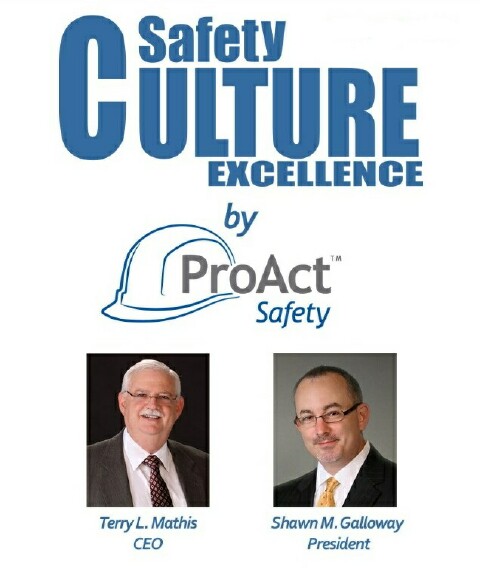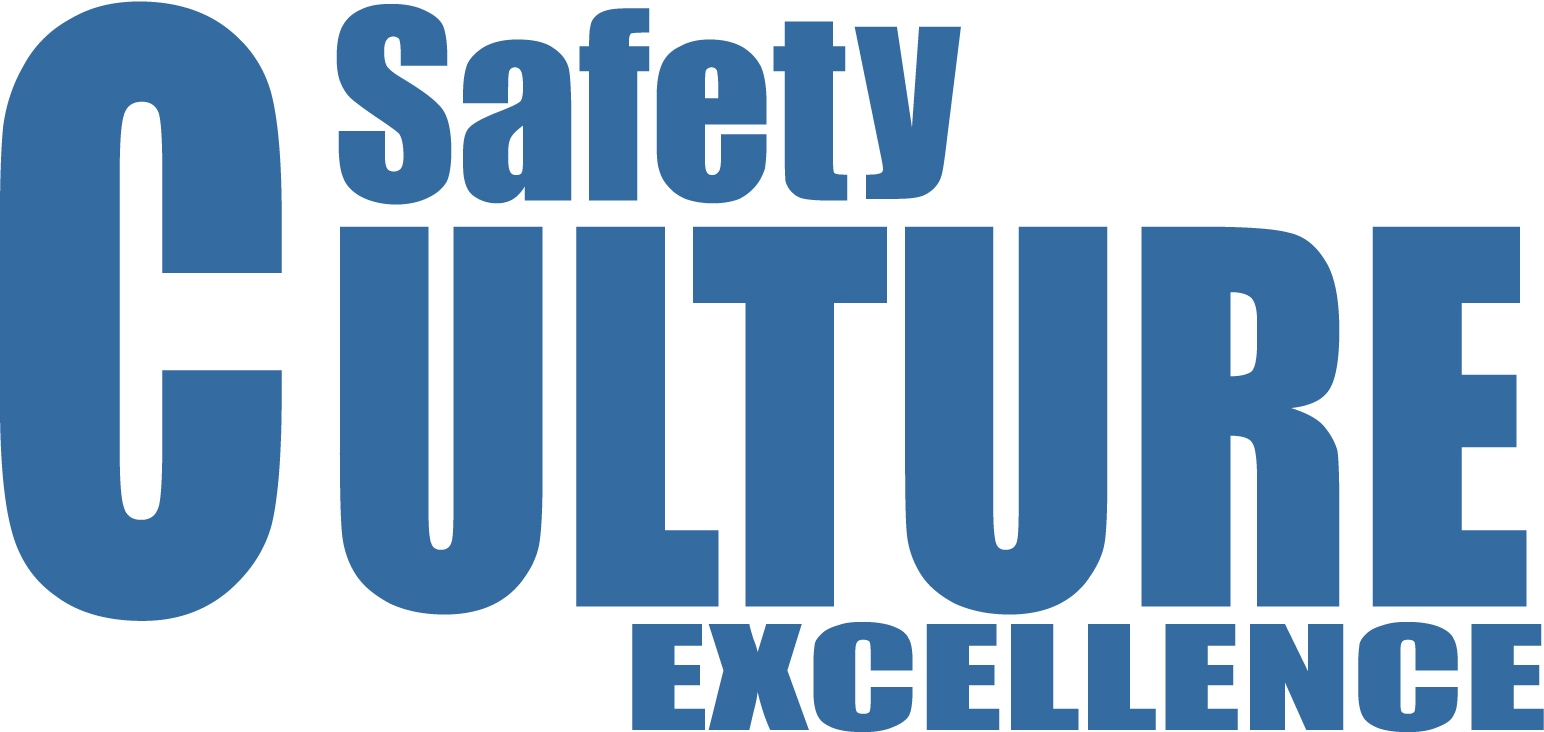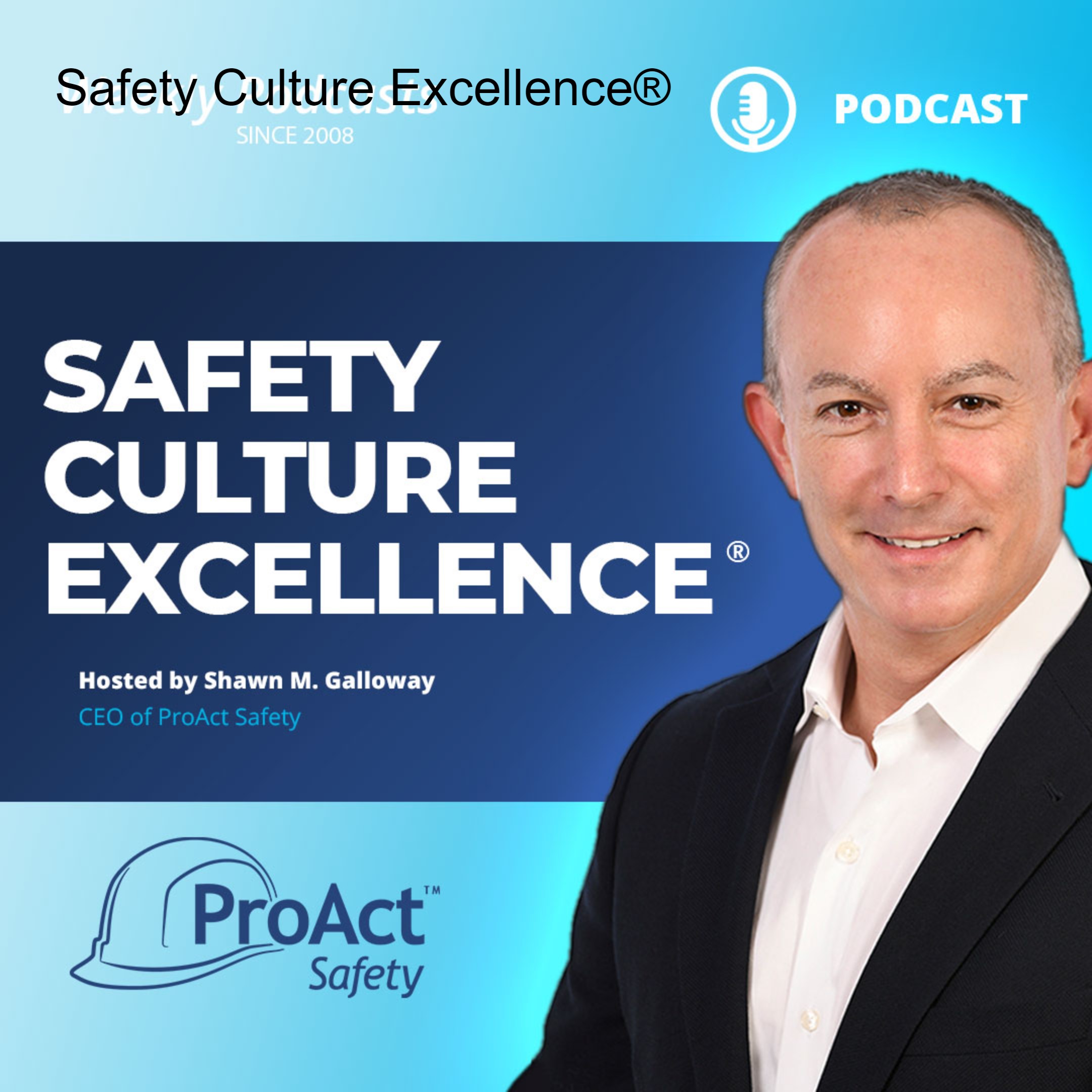Episodes

Monday Apr 14, 2014
337 – To Delegate or Not to Delegate Safety?
Monday Apr 14, 2014
Monday Apr 14, 2014
Greetings everyone, this podcast recorded while in Bangkok, Thailand. I’d like to share an article I wrote that was published April 2014 in OH&S Magazine. The published article can either be found on the magazine’s website or under Insights at www.ProActSafety.com.
I hope you enjoy the podcast this week. If you would like to download or play on demand our other podcasts, please visit the ProAct Safety’s podcast website at: http://www.safetycultureexcellence.com. If you would like access to archived podcasts (older than 90 days – dating back to January 2008) please visit www.ProActSafety.com/Store. For more detailed strategies to achieve and sustain excellence in performance and culture, pick up a copy of our book, STEPS to Safety Culture Excellence - http://proactsafety.com/insights/steps-to-safety-culture-excellence
Have a great week!
Shawn M. Galloway
ProAct Safety

Wednesday Apr 09, 2014
The Lost Art of Listening
Wednesday Apr 09, 2014
Wednesday Apr 09, 2014
The late Stephen Covey said that one of the habits of highly-effective people is to “Seek First to Understand, Then to Be Understood.” Most safety programs do exactly the opposite and are therefore not highly effective. Leaders and safety professionals decide what is needed and deploy new programs and processes without consulting the very people who know the issues in the field, and will ultimately determine the success or failure of new initiatives. Organizations regularly hire consultants to analyze their problems and the consultants get the information to do so directly from the organization’s employees. A good consultant is a good listener first and a good problem solver second.
But listening is more than just hearing sounds. It begins with setting the right tone for the conversation. There must be a non-threatening and respectful atmosphere in which the listening can take place. There also needs to be an honest and frank expectation of how the information will potentially be used. Skepticism often arises from past interviews or surveys from which no action has been taken. Enough of this kind of skepticism can render the conversation useless.
Sometimes, the right questions need to be asked to spark the right discussions and discover the underlying issues. When issues emerge from the discussions, they need to be probed and understood more fully. That means that the right questions need the right follow-up questions as well. The whole process can build upon itself once those interviewed realize that their input is being valued and can potentially lead to improvements. Listening is ultimately empowering people by taking them seriously.
-Terry L. Mathis
Terry L. Mathis is the founder and CEO of ProAct Safety, an international safety and performance excellence firm. He is known for his dynamic presentations in the fields of behavioral and cultural safety, leadership, and operational performance, and is a regular speaker at ASSE, NSC, and numerous company and industry conferences. EHS Today listed Terry as a Safety Guru in ‘The 50 People Who Most Influenced EHS in 2010, 2011 and 2012-2013. He has been a frequent contributor to industry magazines for over 15 years and is the coauthor of STEPS to Safety Culture Excellence, 2013, WILEY.

Thursday Apr 03, 2014
Safety as a Split Job-Title
Thursday Apr 03, 2014
Thursday Apr 03, 2014
Many organizations, especially smaller sites, are making safety part of someone’s job title. It may be HR/Safety, Plant Engineer/Safety, Environmental/Safety, Health/Safety or some other combination. I seldom see “safety” listed first on such combined titles. Is that intentional or do the words just sound better in that order? In the majority of cases, it is the safety responsibility that is the “add-on” and the person assigned is another kind of professional and a part-time advocate of safety.
Having even a part-time safety point person can be better than having none; but there is a definite downside to this arrangement as well. It can send the message that safety is not important enough to dedicate a professional to it. It can also suggest that safety is not all that complex and a little attention is all that is needed. Not everyone takes these kinds of inferences from such an arrangement, but it often happens.
The most common problem with such assignments is that safety is seriously subjugated to the other job because that is where the expertise and interest lies. Safety is more or less a hobby that gets whatever extra time is available. Communications from the safety person are less than expert and less than official.
If your organization has such dual functions, carefully define the division of responsibilities, provide professional development for the safety function, calendar the first year’s safety activities and follow-up to see that they are accomplished, and periodically ask the personnel at the site how the safety function is going and how it could be improved. Today’s economic reality calls on many individuals to wear multiple hats. Just be sure one hat, doesn’t wind up in the closet.
-Terry L. Mathis
Terry L. Mathis is the founder and CEO of ProAct Safety, an international safety and performance excellence firm. He is known for his dynamic presentations in the fields of behavioral and cultural safety, leadership, and operational performance, and is a regular speaker at ASSE, NSC, and numerous company and industry conferences. EHS Today listed Terry as a Safety Guru in ‘The 50 People Who Most Influenced EHS in 2010, 2011 and 2012-2013. He has been a frequent contributor to industry magazines for over 15 years and is the coauthor of STEPS to Safety Culture Excellence, 2013, WILEY.

Wednesday Mar 26, 2014
Can-Do Safety Cultures
Wednesday Mar 26, 2014
Wednesday Mar 26, 2014
It is important to define the desired capabilities of a culture instead of simply the desired characteristics. What a culture “can do” is much more crucial than what it “is like.” That said, some cultures become can-do cultures without internalizing safety as a part of what they can do. Such cultures become “get it done at all costs” cultures. The members of the culture become willing to give their bodies up for the team. They put job completion ahead of all other priorities.
The history of a site can be a major influence in developing such a culture. Sites that have experienced multiple downsizing or threats of closing tend to develop work groups that perform for survival. The constant threat of being laid off or having your workplace closed tends to outweigh the threat of personal injury. If managers and supervisors constantly use these threats to motivate or hurry workers, the perception that production trumps safety is constantly reinforced.
When companies downsize, reorganize or otherwise disrupt site cultures, they should anticipate and manage the safety aspects of the change. Survival is an economic necessity, but poor safety can impact a site’s viability as much as ineffective or incomplete work. Survival mode should include both surviving the economic challenges and the safety issues. Again, it is not a dichotomy between production and safety, but addressing the need for safe production.
-Terry L. Mathis
Terry L. Mathis is the founder and CEO of ProAct Safety, an international safety and performance excellence firm. He is known for his dynamic presentations in the fields of behavioral and cultural safety, leadership, and operational performance, and is a regular speaker at ASSE, NSC, and numerous company and industry conferences. EHS Today listed Terry as a Safety Guru in ‘The 50 People Who Most Influenced EHS in 2010, 2011 and 2012-2013. He has been a frequent contributor to industry magazines for over 15 years and is the coauthor of STEPS to Safety Culture Excellence, 2013, WILEY.

Monday Mar 24, 2014
334 – Misunderstanding the Role of Safety Culture Assessments
Monday Mar 24, 2014
Monday Mar 24, 2014
Greetings everyone, this podcast recorded while in my home in Texas. I’d like to share an article I wrote that was published March 2014 in Occupational Health and Safety Magazine. The published article can either be found on the magazine’s website or under Insights at www.ProActSafety.com.
I hope you enjoy the podcast this week. If you would like to download or play on demand our other podcasts, please visit the ProAct Safety’s podcast website at: http://www.safetycultureexcellence.com. If you would like access to archived podcasts (older than 90 days – dating back to January 2008) please visit www.ProActSafety.com/Store. For more detailed strategies to achieve and sustain excellence in performance and culture, pick up a copy of our book, STEPS to Safety Culture Excellence - http://proactsafety.com/insights/steps-to-safety-culture-excellence
Have a great week!
Shawn M. Galloway
ProAct Safety

Wednesday Mar 19, 2014
Site vs. Corporate Support Safety Staff: How Does the Job Get Done?
Wednesday Mar 19, 2014
Wednesday Mar 19, 2014
We have seen a trend in recent years for organizations to add safety staff at the corporate level rather than at the site level. The basic idea is that these corporate staffers can be shared among sites who might not need them full time. The idea is valid on the surface. Shared resources could have higher levels of competence, could be more specialized, and could be paid more than the site budget could bear. Having a floating pool of resource people also allows companies to send more help to sites when needed.
The downside of this practice is the disconnection between these corporate resource people and the sites. Many view their job as exercising their field of expertise rather than addressing the needs of the site. They tend to become subject-matter experts rather than support staff. They also tend to function better with technical issues than with people issues. All these tendencies can potentially make them less useful to the site. When this reduced effectiveness is combined with the fact that their jobs might effectively eliminate site-specific jobs, this becomes a double blow to the site safety program.
The best ways to address these potential problems is to consider the relationship of corporate support staff with site mangers. When corporate folks are assigned to the manager rather than a specific site issue, things tend to get done. Effective managers tend to seek solutions rather than fixes. They, if effective, will have deeper knowledge of the people issues at the site and include them in the solutions. Managers that aim the expertise of corporate people at site issues in a more holistic manner, will make relationships more effective.
-Terry L. Mathis
Terry L. Mathis is the founder and CEO of ProAct Safety, an international safety and performance excellence firm. He is known for his dynamic presentations in the fields of behavioral and cultural safety, leadership, and operational performance, and is a regular speaker at ASSE, NSC, and numerous company and industry conferences. EHS Today listed Terry as a Safety Guru in ‘The 50 People Who Most Influenced EHS in 2010, 2011 and 2012-2013. He has been a frequent contributor to industry magazines for over 15 years and is the coauthor of STEPS to Safety Culture Excellence, 2013, WILEY.

Monday Mar 10, 2014
332 - Shaping the Safety Culture of Project-Based Workforces
Monday Mar 10, 2014
Monday Mar 10, 2014
Greetings everyone, this podcast recorded while in Morgan City, LA. I’d like to share an article Terry L. Mathis wrote that was published February 2014 in EHS Today Magazine. The published article can either be found on the magazine’s website or under Insights at www.ProActSafety.com.
I hope you enjoy the podcast this week. If you would like to download or play on demand our other podcasts, please visit the ProAct Safety’s podcast website at: http://www.safetycultureexcellence.com. If you would like access to archived podcasts (older than 90 days – dating back to January 2008) please visit www.ProActSafety.com/Store. For more detailed strategies to achieve and sustain excellence in performance and culture, pick up a copy of our book, STEPS to Safety Culture Excellence - http://proactsafety.com/insights/steps-to-safety-culture-excellence
Have a great week!
Shawn M. Galloway
ProAct Safety

Wednesday Mar 05, 2014
Heads and Habits
Wednesday Mar 05, 2014
Wednesday Mar 05, 2014
I recently attended a safety training session in which the three types of distracted driving were being taught and discussed. I stood outside the door after the training and asked the departing trainees if they could name the three types of distractions. Only one of ten could name two of the three, three more could name one and the rest could not remember any of the three. If those being trained cannot remember the training on the way out of the classroom the chances of them adopting the safety practices and turning them into safety habits is virtually non-existent.
The principle is this, “If you don’t get it into workers’ heads, you won’t get it into their habits.” Training that isn’t memorable or sticky is not effective training. Safety training that does not utilize mnemonic devices, repetition and post-testing may meet legal requirements, but it won’t improve safety performance. Even with such training techniques, too much training material can create overload rather than internalization of the materials.
Remember the principle. Before taking workers away from work and putting them in classrooms or in front of computers, consider rethinking your training strategies to make the most effective use of the time and a greater return on investment.
-Terry L. Mathis
Terry L. Mathis is the founder and CEO of ProAct Safety, an international safety and performance excellence firm. He is known for his dynamic presentations in the fields of behavioral and cultural safety, leadership, and operational performance, and is a regular speaker at ASSE, NSC, and numerous company and industry conferences. EHS Today listed Terry as a Safety Guru in ‘The 50 People Who Most Influenced EHS in 2010, 2011 and 2012-2013. He has been a frequent contributor to industry magazines for over 15 years and is the coauthor of STEPS to Safety Culture Excellence, 2013, WILEY.

Monday Mar 03, 2014
331 - Profound Knowledge: What Drives Your Safety Strategy
Monday Mar 03, 2014
Monday Mar 03, 2014
Greetings everyone, this podcast recorded while in Gonzales, LA. I’d like to share an article I wrote that was published February 2014 in OH&S Magazine. The published article can either be found on the magazine’s website or under Insights at www.ProActSafety.com.
I hope you enjoy the podcast this week. If you would like to download or play on demand our other podcasts, please visit the ProAct Safety’s podcast website at: http://www.safetycultureexcellence.com. If you would like access to archived podcasts (older than 90 days – dating back to January 2008) please visit www.ProActSafety.com/Store. For more detailed strategies to achieve and sustain excellence in performance and culture, pick up a copy of our book, STEPS to Safety Culture Excellence - http://proactsafety.com/insights/steps-to-safety-culture-excellence
Have a great week!
Shawn M. Galloway
ProAct Safety

Wednesday Feb 19, 2014
Safety: Finding the Right Mix of Idealism and Realism
Wednesday Feb 19, 2014
Wednesday Feb 19, 2014
Are all accidents preventable? The idealist says that, under the right circumstances and with early detection of risks and trends, they are. The realist says that given probability, massive exposure to risks, human nature and imperfect performance a certain number of accidents are inevitable. Which view is right and which is wrong?
A pure idealist’s mentality implies that any rate of failure is unacceptable. A pure realist’s mentality implies that it is ok to hurt workers since it is unavoidable. Either of these extremes tends to produce philosophically flawed and, thus, ineffective safety programs.
The most effective safety effort is neither blind to the magnitude of the challenge nor resigned to accept some level of failure. Likewise, the most effective safety effort is always intelligently adapting but never knee-jerk reacting. Where the idealist would fail to adapt and the realist overreact, the effective safety professional continuously analyzes and improves the approach, always looking for the next better way to improve safety. It is possible to dream the impossible dream without tilting with windmills.
-Terry L. Mathis
Terry L. Mathis is the founder and CEO of ProAct Safety, an international safety and performance excellence firm. He is known for his dynamic presentations in the fields of behavioral and cultural safety, leadership, and operational performance, and is a regular speaker at ASSE, NSC, and numerous company and industry conferences. EHS Today listed Terry as a Safety Guru in ‘The 50 People Who Most Influenced EHS in 2010, 2011 and 2012-2013. He has been a frequent contributor to industry magazines for over 15 years and is the coauthor of STEPS to Safety Culture Excellence, 2013, WILEY.

